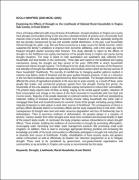| dc.description.abstract | IGOLA WINFRED (2009-MO91-10005)
Examining the Effects of Drought on the Livelihoods of Selected Rural Households in Ongino
Sub-County, in Kumi District
Once a thriving settlement with many fortunes of livelihoods, drought situations in Ongino sub-county
have plunged communities living in this area into a desolate enclave of poverty and a chronically food
insecure zone in Kumi district. Drought has become more frequent in this zone, especially during the
last two decades characterised by low and variable rainfall distribution. In the past, rural households
thrived through the cattle, crop, fish and forest economy as a major source for family incomes, which
supported the family‟s ambitions to improve their economic wellbeing, until a few years ago when
frequent droughts started reversing their fortunes. This study attempts to report on the effects of
drought on the livelihood and coping mechanisms of the people living in Ongino sub-county during
drought situations. The study is based on both quantitative and qualitative data collected from
households and local leaders in the community. These data were based on the livelihood and coping
mechanisms during the drought and lean period of the years 2008-2009 in which households
experienced intense drought hazards. The findings from the study show that, increase of the frequency
and intensity of drought has affected the agriculture and livestock sectors which are the key sources of
these households‟ livelihoods. The scarcity of rainfall due to changing weather patterns resulted in
massive crop failure, death of livestock and also poor quality livestock products. A loss or a reduction
in the non-farm livelihoods was also experienced by these households. The drought phenomenon also
affected the prices of agricultural products in the area due to acute scarcity; as a result of these, some
people like traders and commercial producers gained from this drought. During this period, the
households of this area adapted a range of livelihood coping mechanisms to reduce their vulnerability.
The present study reports some of these as being; relying on the social support system, reduction of
food consumption and change in the nature of the food consumed in households with low food and
income stocks. Majority of the people depended on external markets for food stuff and seed/planting
materials, selling of livestock and labour for family income. Many households also either sold or
mortgaged their land and household assets for survival. Some of the people, including young children
migrated temporary to other places to seek other sources of livelihood. The consequences of direct or
primary effects illustrate indirect or secondary effects and the study analysed these in that order. Other
consequences of drought were land and water resources degradation and loss of biodiversity due to
deforestation. There is enormous evidence of deforestation; the greatest danger in a situation of
poverty. Various studies from other drought prone areas were reviewed and discussed briefly in light
of the present study results. In conclusion the study proposes various interventions to reduce drought
effects. These include; building the resilience of communities to drought by promoting afforestation,
encouraging water harvesting and better water management practices like promoting small scale
irrigation. In addition, there is need to encourage appropriate farming practices and increasing the
knowledge and skills of the local communities to effectively participate in drought risk reduction and
to diversify their source of livelihoods. Finally, rehabilitation of food security stocks and gardens
within communities as well as effectively do disaster risk reduction programmes so as to mitigate
drought. These need to be considered by government, non-governmental organisations and
communities as top priorities in Ongino sub-county as recommended by this study.
Keywords: Drought, Livelihoods, Rural Households, Kumi District | en_US |


